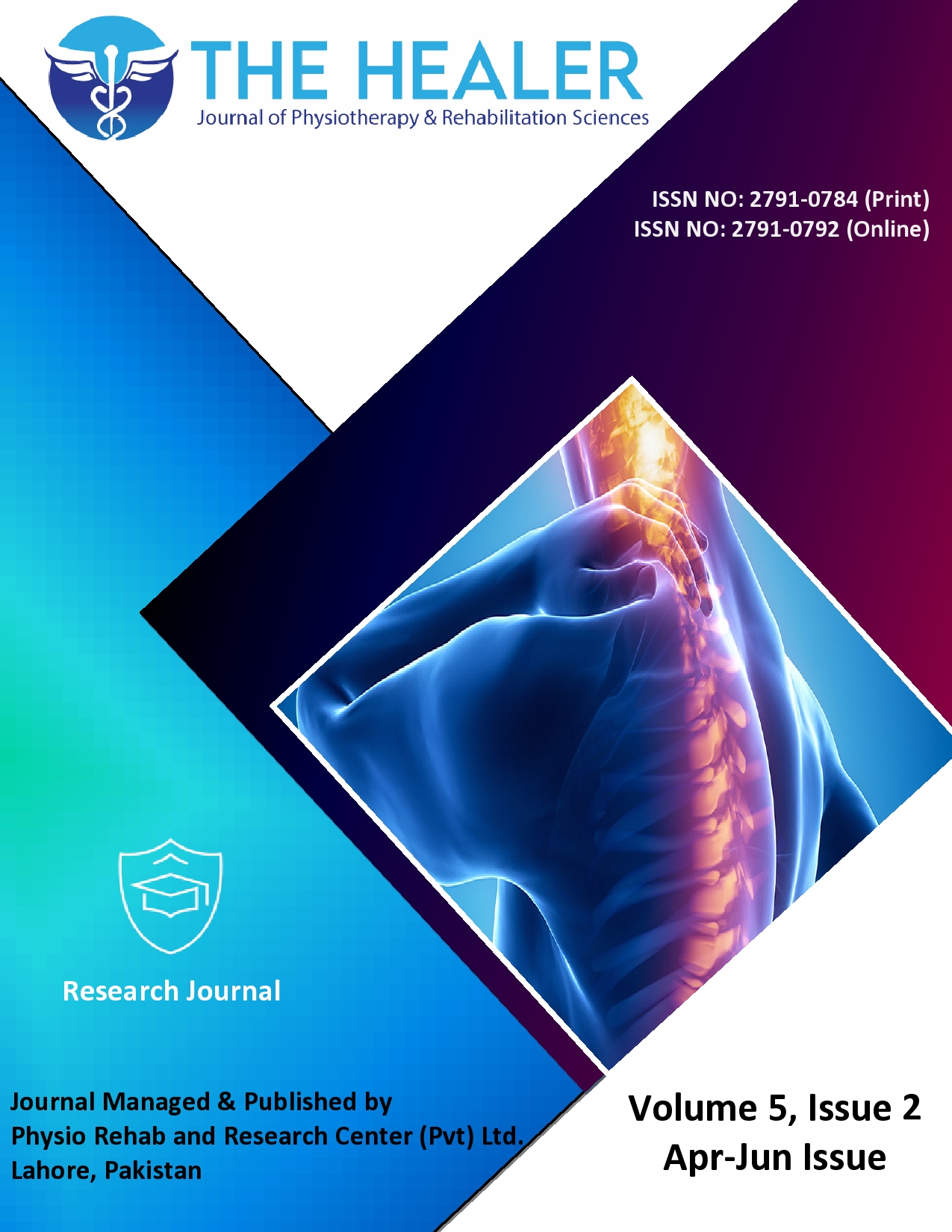Shoulder Impingement Syndrome Associated with Low Thoracic Kyphosis and Intrascapular Myofascial Trigger Point in a 25-Year-Old University Student: A Case Study
DOI:
https://doi.org/10.55735/vze4hv37Keywords:
Myofascial trigger points , Overhead activity , Shoulder dysfunction , Shoulder impingement syndrome , Thoracic kyphosisAbstract
Background: Shoulder impingement syndrome is a common cause of shoulder pain and dysfunction. Flattened thoracic kyphosis may limit scapular posterior tilt and upward rotation, while intrascapular trigger points can increase pain. This case highlights their combined role in impingement syndrome. Objective: To present the clinical features, management, and outcomes of a patient with shoulder impingement syndrome associated with reduced thoracic kyphosis and interscapular myofascial trigger points. Case Presentation: A 25-year-old male student reported 8 months of non-traumatic left shoulder pain aggravated by overhead activity and prolonged sitting. Postural assessment showed reduced thoracic kyphosis and mild shoulder protraction. A trigger point at the inferior-medial border of the left scapula reproduced local pain. Examination revealed a painful arc (70-120°), positive Neer’s and Hawkins-Kennedy tests, mild external rotator weakness, and decreased scapular posterior tilt. This syndrome was linked with thoracic hypokyphosis and an intrascapular trigger point was diagnosed. A multimodal physiotherapy plan was initiated, including thoracic extension mobility exercises, ischemic compression, scapular stabilization, rotator cuff strengthening, and ergonomic advice. Over 12 weeks, the patient showed reduced pain, improved range of motion, better thoracic extension, and enhanced function. Trigger point tenderness decreased, and scapular kinematics normalized. Discussion: This case highlights the complex relationship between thoracic spine alignment, scapular mechanics, and impingement syndrome in a young adult. The patient presented with low thoracic kyphosis, intrascapular myofascial trigger points, and symptoms consistent with impingement syndrome. Most existing literature has focused on the impact of excessive thoracic kyphosis on shoulder dysfunction. Conclusion: This case emphasizes that low thoracic kyphosis and intrascapular trigger points can play a contributory role in SIS, especially in young adults. Addressing thoracic posture, myofascial dysfunction, and shoulder mechanics through a comprehensive rehabilitation approach can lead to significant clinical improvements.
Downloads
References
1. Ludewig PM, Braman JP. Shoulder impingement: biomechanical considerations in rehabilitation. Manual Therapy 2011; 16(1): 33-9.
https://doi.org/10.1016/j.math.2010.08.004 DOI: https://doi.org/10.1016/j.math.2010.08.004
2. Bukhari B, Ali S, Afzal S. Thoracic spinal thrust manipulation for shoulder impingement syndrome: A meta-analysis of pain relief and functional outcomes. Journal of Pakistan Medical Association 2025; 75(3): 456-61.
https://doi.org/10.47391/JPMA.11608 DOI: https://doi.org/10.47391/JPMA.11608
3. Tauqeer S, Arooj A, Shakeel H. Effects of manual therapy in addition to stretching and strengthening exercises to improve scapular range of motion, functional capacity, and pain in patients with shoulder impingement syndrome: a randomized controlled trial. BMC Musculoskeletal Disorders 2024; 25(1): 192.
https://doi.org/10.1186/s12891-024-07294-4 DOI: https://doi.org/10.1186/s12891-024-07294-4
4. Cao W, Yin L, Sun H, Ge H, Guo R, Lyu X. Ultrasound features of myofascial trigger points: a multimodal study integrating preliminary histological findings from the upper trapezius. Scientific Reports 2025; 15(1): 20510.
https://doi.org/10.1038/s41598-025-05869-2 DOI: https://doi.org/10.1038/s41598-025-05869-2
5. Bae M-J, Hong J-K, Kim E-J. Evaluation of the impacts of abandoned mining areas: a case study with benthic macroinvertebrate assemblages. International Journal of Environmental Research and Public Health 2021; 18(21): 11132.
https://doi.org/10.3390/ijerph182111132 DOI: https://doi.org/10.3390/ijerph182111132
6. Huang L-L, Huang T-S, Lin Y-H, Huang C-Y, Yang J-L, Lin J-J. Effects of upper trapezius myofascial trigger points on scapular kinematics and muscle activation in overhead athletes. Journal of Human Kinetics 2022; 84: 32-42.
https://doi.org/10.2478/hukin-2022-000079 DOI: https://doi.org/10.2478/hukin-2022-000079
7. Shin S-J, Lee S, Hwang JY, Lee W, Koh KH. Tear pattern after superior capsular reconstruction using an acellular dermal matrix allograft. Journal of Shoulder and Elbow Surgery 2022; 31(6): e279-e88.
https://doi.org/10.1016/j.jse.2021.12.009 DOI: https://doi.org/10.1016/j.jse.2021.12.009
8. Verschueren J, Tassignon B, Verhagen E, Meeusen R. The interaction of acute physical fatigue with three traditional functional performance tests and the reactive balance test. Physical Therapy in Sport 2021; 49: 188-95.
https://doi.org/10.1016/j.ptsp.2021.03.004 DOI: https://doi.org/10.1016/j.ptsp.2021.03.004
9. Coronado RA, Master H, Bley JA, et al. Patient-centered goals after lumbar spine surgery: a secondary analysis of cognitive-behavioral-based physical therapy outcomes from a randomized controlled trial. Physical Therapy 2022; 102(9): pzac091.
https://doi.org/10.1093/ptj/pzac091 DOI: https://doi.org/10.1093/ptj/pzac091
10. Park SJ, Kim SH, Kim SH. Effects of thoracic mobilization and extension exercise on thoracic alignment and shoulder function in patients with subacromial impingement syndrome: A randomized controlled pilot study. Healthcare (Basel) 2020; 8(3): 316.
https://doi.org/10.3390/healthcare8030316 DOI: https://doi.org/10.3390/healthcare8030316
11. Zhong Z, Zang W, Tang Z, Pan Q, Yang Z, Chen B. Effect of scapular stabilization exercises on subacromial pain (impingement) syndrome: a systematic review and meta-analysis of randomized controlled trials. Frontiers in Neurology 2024; 15: 1357763.
https://doi.org/10.3389/fneur.2024.1357763 DOI: https://doi.org/10.3389/fneur.2024.1357763
12. Navarro-Santana MJ, Gomez-Chiguano GF, Cleland JA, Arias-Buria JL, Fernández-De-Las-Peñas C, Plaza-Manzano G. Effects of trigger point dry needling for nontraumatic shoulder pain of musculoskeletal origin: a systematic review and meta-analysis. Physical Therapy 2021; 101(2): pzaa216.
https://doi.org/10.1093/ptj/pzaa216 DOI: https://doi.org/10.1093/ptj/pzaa216
13. Stocker N, Froeschke L, Kraus R. Restorative exercise models in dysphagia and obstructive sleep apnea: a review. Archives of Physical Medicine and Rehabilitation 2022; 103(3): e6.
https://doi.org/10.1016/j.apmr.2022.01.015 DOI: https://doi.org/10.1016/j.apmr.2022.01.015
14. Yuksel E, Yesilyaprak SS. Scapular stabilization exercise training improves treatment effectiveness on shoulder pain, scapular dyskinesis, muscle strength, and function in patients with subacromial pain syndrome: a randomized controlled trial. Journal of Bodywork and Movement Therapies 2024; 37: 101-8.
https://doi.org/10.1016/j.jbmt.2023.11.005 DOI: https://doi.org/10.1016/j.jbmt.2023.11.005
15. Hunter DJ, Rivett DA, McKeirnan S, Smith L, Snodgrass SJ. Relationship between shoulder impingement syndrome and thoracic posture. Physical therapy 2020; 100(4): 677-86.
https://doi.org/10.1093/ptj/pzz182 DOI: https://doi.org/10.1093/ptj/pzz182

Downloads
Published
License
Copyright (c) 2025 The Healer Journal of Physiotherapy and Rehabilitation Sciences

This work is licensed under a Creative Commons Attribution 4.0 International License.














